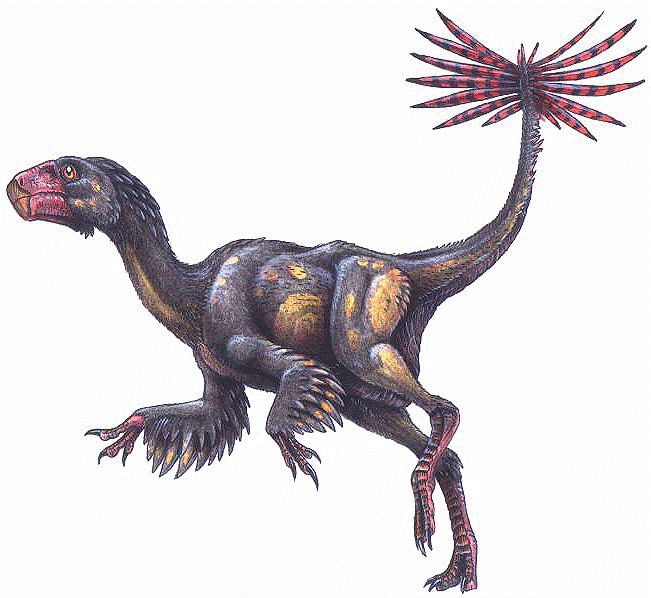|
Caudipteryx zoui (Ji,
Currie, Norell & Ji. 1998) |
|
 |
|
Name Means: |
"Zou's tail feathers" |
Length: |
3 feet (1 m) |
|
Pronounced: |
cow-DIP-tuh-riks |
Weight: |
15 pounds (6 - 7 kilos) |
|
When it lived: |
Early Cretaceous - 140 MYA |
|
|
|
Where found: |
Liaoning Province, China |
|
|
|
Caudipteryx is one of several types of feathered dinosaurs
recently discovered in China during 1998. These new finds have caused one of the
greatest controversies in modern paleontology. They have many of the
characteristics that were expected in a "missing link" between
dinosaurs and birds, but they lived millions of years after
Archaeopteryx, the first known bird ancestor.
Caudipteryx was a turkey-sized dinosaur. It had short
forelimbs, large eyes and long, sharp, spiked teeth. Quick and agile,
it had long slender legs. The most prominent feature of Caudipteryx had to be its tail, which
was covered with 6-inch-long tail feathers. The feather fossils show
bands of dark and light that may have been color, giving us an idea of
how Caudipteryx looked. It was unable to fly. Some of the evolutionary advantages feathers may have provided to a
flightless animal may include the ability to control body heat, some
protection from teeth and claws, camouflage and identification. Since
Caudipteryx lived in a wetland area, it is easy to imagine it
wading into shallow water on its long legs to spear small fish and
amphibians with its long sharp teeth.
The has an osseous stem on the front arm lever, a
characteristic found in modern birds. In the
birds, the wings are fixed on similar stems, but it is not known if
this character appeared before the invention of the wings and that it
made it possible this new type of member to develop, nor if it were
sufficient to allow the flight if necessary. Thus there is not
yet enough information to know if Avimimus had wings and if
they were functional.
It is nearly unique among classic theropods in that it is
known to have had a gizzard full of stones to aid digestion.
They were about an inch in size. This indicates Caudipteryx did not chew
its food, probably swallowing small prey whole.
Since both sauropodomorphs and birds are known to have had such gizzards, it
is probable other theropods had them too. Besides stomach stones, it
had small conical teeth. Caudipteryx gets its name from its
long tail feathers.
Did
Archaeopteryx and Caudipteryx descend from a common
ancestor? Or was Caudipteryx a dinosaur sharing a convergent
evolution with birds. This will be a long and lively debate.
Paleontologist Philip Currie and assistant Kevin Aulenback of
the Royal Tyrrell Museum of Paleontology were in Beijing examining
three specimens identified as Protarchaeopteryx with Ji Qiang,
director of China’s National Geological Museum. Curried renamed
it Caudipteryx “tail feather” - for the tall plumes that
the creature likely fanned for display. Caudipteryx becomes the
fourth “feathered” animal to be found near the tiny village of Sihetun
in Liaoning Province. It joins Protarchaeopteryx and
Confuciusornis—a creature with relatively short, clawed wings that
was probably one of the first birds to fly well—and
Sinosauropteryx, one of the most important dinosaur finds of the
20th century.
Currie stated, "For the first time we have something that is
unquestionably a dinosaur with unquestionable feathers. So what we
have is a missing link between meat-eating dinosaurs and the earliest
bird. This shows that dinosaurs are not extinct, but are
well-represented by 10,000 species of birds."
“The discoveries of those feathered creatures from the western part
of Liaoning Province, northeast China, certainly support the
hypothesis that birds were derived directly from small theropod
dinosaurs,” Ji said. “They make the relationship between dinosaurs and
birds closer and closer, but they also make the definition and concept
of birds more and more indistinct.”
The existence of Protarchaeopteryx, Sinosauropteryx, and
Caudipteryx lends credence to the theory the birds are descended from
theropod dinosaurs and not from 4-legged arboreal (tree living)
reptiles. There are, however, dissenting voices who point out that the
new feathered fossils are from a time after that of Archaeopteryx, the
first bird (which lived about 147 million years ago, before
Caudipteryx and Protarchaeopteryx). This suggests that perhaps the
fossils' resemblance to birds could be a case of convergent evolution
and that their feathers evolved for insulation, not flight, indicating
a warm-blooded physiology. |
|
|
|
|
|
|
|
|
Edugraphics.Net | Feenixx Publishing |
|
|
|
|
![]()
